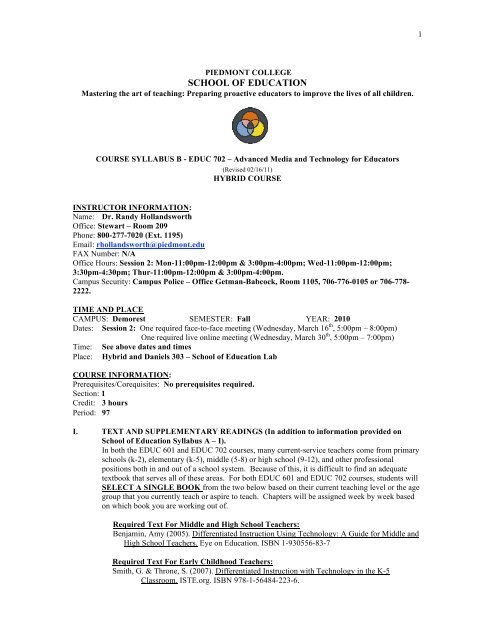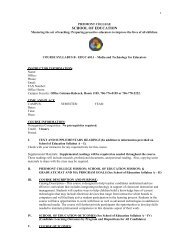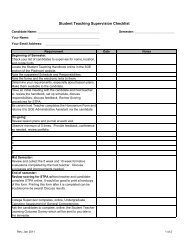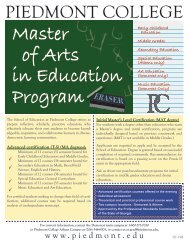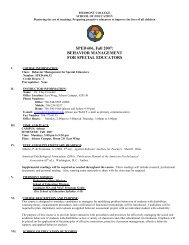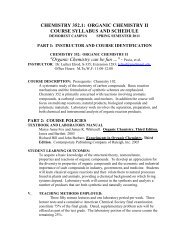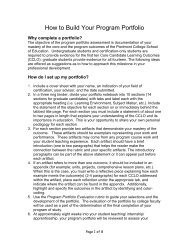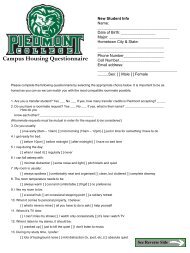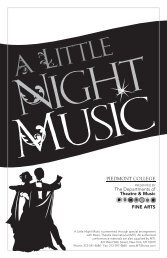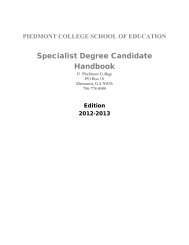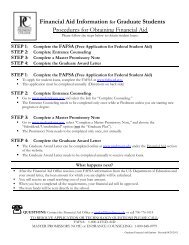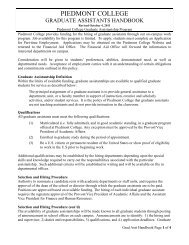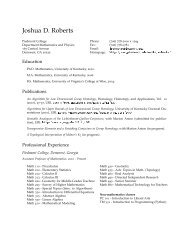EDUC 702 Integrating Instructional Media and ... - Piedmont College
EDUC 702 Integrating Instructional Media and ... - Piedmont College
EDUC 702 Integrating Instructional Media and ... - Piedmont College
You also want an ePaper? Increase the reach of your titles
YUMPU automatically turns print PDFs into web optimized ePapers that Google loves.
1PIEDMONT COLLEGESCHOOL OF <strong>EDUC</strong>ATIONMastering the art of teaching: Preparing proactive educators to improve the lives of all children.COURSE SYLLABUS B - <strong>EDUC</strong> <strong>702</strong> – Advanced <strong>Media</strong> <strong>and</strong> Technology for Educators(Revised 02/16/11)HYBRID COURSEINSTRUCTOR INFORMATION:Name: Dr. R<strong>and</strong>y Holl<strong>and</strong>sworthOffice: Stewart – Room 209Phone: 800-277-<strong>702</strong>0 (Ext. 1195)Email: rholl<strong>and</strong>sworth@piedmont.eduFAX Number: N/AOffice Hours: Session 2: Mon-11:00pm-12:00pm & 3:00pm-4:00pm; Wed-11:00pm-12:00pm;3:30pm-4:30pm; Thur-11:00pm-12:00pm & 3:00pm-4:00pm.Campus Security: Campus Police – Office Getman-Babcock, Room 1105, 706-776-0105 or 706-778-2222.TIME AND PLACECAMPUS: Demorest SEMESTER: Fall YEAR: 2010Dates: Session 2: One required face-to-face meeting (Wednesday, March 16 th , 5:00pm – 8:00pm)One required live online meeting (Wednesday, March 30 th , 5:00pm – 7:00pm)Time: See above dates <strong>and</strong> timesPlace: Hybrid <strong>and</strong> Daniels 303 – School of Education LabCOURSE INFORMATION:Prerequisites/Corequisites: No prerequisites required.Section: 1Credit: 3 hoursPeriod: 97I. TEXT AND SUPPLEMENTARY READINGS (In addition to information provided onSchool of Education Syllabus A – I).In both the <strong>EDUC</strong> 601 <strong>and</strong> <strong>EDUC</strong> <strong>702</strong> courses, many current-service teachers come from primaryschools (k-2), elementary (k-5), middle (5-8) or high school (9-12), <strong>and</strong> other professionalpositions both in <strong>and</strong> out of a school system. Because of this, it is difficult to find an adequatetextbook that serves all of these areas. For both <strong>EDUC</strong> 601 <strong>and</strong> <strong>EDUC</strong> <strong>702</strong> courses, students willSELECT A SINGLE BOOK from the two below based on their current teaching level or the agegroup that you currently teach or aspire to teach. Chapters will be assigned week by week basedon which book you are working out of.Required Text For Middle <strong>and</strong> High School Teachers:Benjamin, Amy (2005). Differentiated Instruction Using Technology: A Guide for Middle <strong>and</strong>High School Teachers. Eye on Education. ISBN 1-930556-83-7Required Text For Early Childhood Teachers:Smith, G. & Throne, S. (2007). Differentiated Instruction with Technology in the K-5Classroom. ISTE.org. ISBN 978-1-56484-223-6.
2Books may be ordered online through the <strong>Piedmont</strong> <strong>College</strong> Bookstore website athttps://secure.bncollege.com or through Amazon at www.amazon.com . Purchasing both ofthese books is NOT REQUIRED, please just select one that aligns with your degree program.The reading assignments for the various books are organized with the weekly modules in broadcategories that the chapters cover both books. When a weekly assignment instructs you to read theIntroductory Chapters, you can assess what chapters are due by the following matrix:Chapter CategoriesDifferentiated Instruction UsingTechnology: A Guide for Middle <strong>and</strong>High School TeachersDifferentiated Instruction withTechnology in the K-5ClassroomIntroductory Chapters 1 - 2 Chapter 1Organization Chapters 3-4 & 9 Chapters 2 <strong>and</strong> 3<strong>Instructional</strong> Delivery Chapters 5-6 Chapters 4-5-6<strong>Instructional</strong> Support Chapters 10 Chapters 7-8Learning Assessment Chapter 7 Chapter 9Classroom Management Chapters 8,11, & 12 Chapter 10Supplemental Materials: Supplemental research <strong>and</strong> professional articles will be requiredthroughout the course. These articles will be placed in Moodle <strong>and</strong> will be in pdf documentformatting.II.III.IV.PIEDMONT COLLEGE MISSION; SCHOOL OF <strong>EDUC</strong>ATION MISSION; &GRADUATE MAT AND MA PROGRAM GOALS (See School of Education Syllabus A – II)COURSE DESCRIPTION AND PURPOSE:The dynamic nature of technology <strong>and</strong> attendant application to classroominstruction/management dem<strong>and</strong>s a similar response from educators <strong>and</strong> thosewho prepare educators. This course will provide the skills necessary for thecontinuation of learning, teaching, <strong>and</strong> practicing the use of technology in theprofession of knowledge broker. The students who successfully complete thechallenging requirements of <strong>EDUC</strong> <strong>702</strong> will exhibit an in-depth comprehension ofthose tools <strong>and</strong> appropriate applications currently found in the k-12 instructionalenvironment. The specific purpose of <strong>EDUC</strong> <strong>702</strong> is to satisfy the Program Goalsas shown in Syllabus A for the School of Education.SCHOOL OF <strong>EDUC</strong>ATION OUTCOMES (See School of Education Syllabus A – IV)(C<strong>and</strong>idate Learning Outcomes by Program <strong>and</strong> Dispositions for All C<strong>and</strong>idates)Core C<strong>and</strong>idate Learning Outcomes (CCLOs)Revised Fall 2009 – Effective January 1, 2010These CCLOs serve as a continually evolving guide to teacher development, practice, <strong>and</strong>decision-making. For these CCLOs to guide our development as educators <strong>and</strong> become the habitsof mind that drive what we do, faculty <strong>and</strong> c<strong>and</strong>idates must engage them in recurring dialogue,application, <strong>and</strong> reflection.1. Learning environment: The teacher uses an underst<strong>and</strong>ing of individual <strong>and</strong> group motivation tocreate a community of learners that encourages positive social interaction, active engagement inthe subject matter, <strong>and</strong> the development of a sense of responsibility for their own learning.2. Subject matter: The scholarly teacher underst<strong>and</strong>s <strong>and</strong> models the central concepts <strong>and</strong> modes ofinquiry of his or her discipline(s), thereby engaging students in learning experiences thatencourage critical thinking <strong>and</strong> stimulate continuing interest in the subject.3. Student learning: Based on an underst<strong>and</strong>ing of how students develop <strong>and</strong> learn, the teacherprovides learning opportunities that support students’ intellectual, social <strong>and</strong> personal growth.
34. Diversity: Underst<strong>and</strong>ing that each learner is unique, the teacher of a democratic classroom adapts<strong>and</strong> differentiates instruction to meet diverse needs of all students.5. <strong>Instructional</strong> strategies: The teacher implements instructional strategies, including appropriate useof instructional technologies, designed to encourage students to develop critical thinking,performance skills, <strong>and</strong> content knowledge, while meeting required curriculum <strong>and</strong> programevaluation st<strong>and</strong>ards.6. Assessment strategies: To foster knowledgeable <strong>and</strong> inquisitive learners, the teacher uses a varietyof formative <strong>and</strong> summative assessments to evaluate student achievement <strong>and</strong> inform instructionaldecision-making.7. Communication: The teacher uses verbal <strong>and</strong> non-verbal communication strategies alongwith complementary technologies to foster active inquiry, collaboration, <strong>and</strong> supportiveinteraction in the classroom.8. Research: The teacher’s professional practices reflect discerning uses of relevant research, as wellas the ability to initiate systematic inquiry into instructional practices <strong>and</strong> school-wide issues.9. Reflection <strong>and</strong> professional development: The teacher is a reflective, critical, open-mindedpractitioner who continually evaluates his/her practices, beliefs, <strong>and</strong> the effects of her/hisdecisions, thereby refining a personal pedagogy to guide professional practices.10. Collaboration: The teacher communicates <strong>and</strong> collaborates democratically with other teachers,families, <strong>and</strong> members of the school’s communities to support student learning <strong>and</strong> well-being.V. COURSE OUTCOMES :Upon successful completion of this course, the c<strong>and</strong>idate will be able to:1) Learn to use the basic functions <strong>and</strong> features of the Microsoft Windows OperatingSystem including startup, desktop use <strong>and</strong> management, working with a variety of storagedrives, printers, <strong>and</strong> other accessories. (CCLO: 2)2) Produce a variety of text <strong>and</strong> graphic documents that take advantage of the editing <strong>and</strong>formatting features in various software applications, such as Microsoft Word 2007.(CCLO: 7)3) Develop presentations using available presentation software. (CCLO: 2, 7)4) Develop spreadsheets that include formulas, graphs, alpha <strong>and</strong> numeric data, statisticalanalyses, data extraction, etc. (CCLO: 2)5) Setup <strong>and</strong> use various email systems to effectively communicate with colleagues,students, <strong>and</strong> parents. (CCLO: 7, 10)6) Plan, design, create, <strong>and</strong> publish a web site in support of specific instructional goals.(CCLO: 2, 7, 10)7) Use browser software to locate <strong>and</strong> manipulate informational <strong>and</strong> instructional resourcesfrom the World Wide Web to engage in continuous professional development <strong>and</strong>lifelong learning. (CCLO: 2, 9)8) Be knowledgeable of how to review, evaluate, classify, organize, purchase, <strong>and</strong> installinstructional <strong>and</strong> productivity applications relevant to their instructional responsibilities.(CCLO: 2, 3, 7, 5)9) Be familiar with instructional resources available via the Internet, as well as otherpertinent technologies, <strong>and</strong> plan for the incorporation of selected resources into thelearning process. (CCLO: 1.2,3)10) Review <strong>and</strong> reflect on a variety of print <strong>and</strong> electronic resources related to technology ingeneral <strong>and</strong> instructional technology in particular as applied to student learning <strong>and</strong>empowerment. (CCLO: 1, 3, 5, 6, 8)11) Design developmentally appropriate learning opportunities that apply technologyenhancedinstructional <strong>and</strong> assessment strategies to support the diverse needs of learners<strong>and</strong> plan strategies to manage student learning in a technology-enhanced environment .(CCLO: 3, 4, 5, 6, 8)12) Identify instructional st<strong>and</strong>ards (i.e. Georgia GPS <strong>and</strong>/or ISTE) <strong>and</strong> plan for theincorporation of selected technology into instruction to facilitate learning for all studentsincluding diverse students’ special needs in self-esteem, attitudes, <strong>and</strong> the inclusion of theexceptional child. (CCLO: 2, 3, 8)
4CIDADANIACIDADANIAA PRINCIPAL CONQUISTA DOS BRASILEIROSO Brasil consolidou notáveis avanços institucionais,sociais e econômicos nas últimasdécadas, especialmente com a reconquistado Estado democrático, mas somos um paísainda em construção. Há uma enorme tarefaa ser realizada em todos os campos, se sonhamoscom uma nação mais moderna, maisjusta, mais generosa com seus filhos. O Brasilque produz e gera riquezas, de boas escolas ehospitais, que acolhe suas crianças e idosos,que reconhece os direitos humanos e protegea sua gente, este Brasil deve ser de todos, enão de poucos. A esse território de oportunidadese igualdades compartilhadas por todosdevemos chamar cidadania. A esse Brasil, aindatão distante de tantos brasileiros, devemosdedicar o melhor de nossas energias para torná-lorealidade.A construção da cidadania impõe-se como umdos gr<strong>and</strong>es desafios para o país, seja para oEstado, seja para a sociedade civil. A vida podee deve ser melhor. Com mais justiça, menosmiséria e desemprego, sem exclusão social,sem a violência que assola a juventude. Cidadaniasignifica a eterna vigilância em relação adireitos políticos, sociais e civis, assim como abusca permanente por mais bem-estar econômicoe social para todos. Ao fazer um país melhor,aumentamos o nosso sentimento de pertencimentoà nação. Temos orgulho de nossasconquistas. Ao mesmo tempo, cidadania é oreconhecimento de valores compartilhados,algo de que não se pode abrir mão sem que seperca a identidade de ser o que somos. Ser cidadãoé se reconhecer e reconhecer o outro. Éser único e, simultaneamente, ser coletivo. Éser íntegro como indivíduo e ético como gruposocial.Cada um de nós é portador de sua própria história.Cada um de nós é um cidadão imperfeito,em constante amadurecimento. E é noconvívio diário que estabelecemos as relaçõesque tecem a nossa cidadania, fortalecendo otecido social e construindo uma história comuma todos. A nossa história como nação.Ao Estado, cabe assegurar que as conquistassejam preservadas e ampliadas. Cabe ser intolerantecom a injustiça, de qualquer espécie.Não se pode reconhecer como nação o paísque desampara e maltrata seus filhos.O encontro de cada brasileiro com a cidadaniaplena e sustentável tem sido um dos maisimportantes desafios do Brasil em todas asépocas. A Constituição de 1988 é um marcohistórico e fundamental para a cidadania brasileira,pois representa a vontade da nação dePLANO DE GOVERNO AÉCIO PRESIDENTE
51. Written WorkAll papers (lesson plans) for the course are to be typed using a 12-point serif font (e.g., Times NewRoman, Garamond, Caslon, Century Schoolbook. etc.). Papers should include a title page <strong>and</strong>reference page, be double-spaced, error-free, <strong>and</strong> grammatically correct (including punctuation,spelling, capitalization, etc.). Make good use of writing references such as dictionaries, writingh<strong>and</strong>books, <strong>and</strong> computer spelling <strong>and</strong> grammar checks. All work submitted must be your originalwork created in <strong>and</strong> for this course. It should be referenced properly using APA 6 th (includinginformation from the Internet).Quality is important! Assignments submitted should reflect your professionalism <strong>and</strong> college levelwork. Your writings <strong>and</strong> reflections will be assessed according to the depth, breadth, clarity, <strong>and</strong>accuracy they convey. Be sure to keep a duplicate copy of the electronic file of all submittedwork for your own records.All work for the course is to be in on time by uploading by the deadline. It is the student’sresponsibility to ensure that papers, URL addresses, or other assignments are received bythe professor. Completion of all assignments is required for a passing grade in the course. If atany time you are unclear about assignments or expectations, please contact me for clarification.Other assignments or activities not mentioned in this syllabus may be required as deemednecessary to assure the mastery of the course objectives as stated.3. Academic IntegrityBy accepting admission to <strong>Piedmont</strong> <strong>College</strong>, each c<strong>and</strong>idate makes a commitment to underst<strong>and</strong>,support, <strong>and</strong> abide by the "Academic Integrity Policy" without compromise or exception. Thisclass will be conducted in strict observance of the policy. Refer to your <strong>Piedmont</strong> <strong>College</strong> StudentH<strong>and</strong>book for details.Special Considerations(See School of Education Syllabus A – VI)VII.INSTRUCTIONAL METHODS, DESCRIPTION OF ASSIGNMENTS, & FIELDEXPERIENCES:1. <strong>Instructional</strong> Methods: See School of Education Syllabus A – VII.2. Description of Assignments:All of the assignments for this course are built around the instructional design model ADDIE. Anacademic paper will be written in sections as we progress through the five stages of this model.Additionally, you will complete several assignments based on each stage of the model, to include alearner analysis, school/class technology assessment, lesson design, development of specifictechnology-based instructional strategies, implementation & evaluation plans, <strong>and</strong> reflection ofthe design process. Your final project/presentation may focus on the delivery of a lesson in k-12with a specific technology or one of the other alternative projects may be selected. Thedevelopment of instructional tools <strong>and</strong> your final lesson <strong>and</strong>/or h<strong>and</strong>outs will be posted on anonline wiki portfolio developed by the participant. These assignments may be altered by theprofessor following the collection of the needs assessment, for individual student needs, or toaccommodate the lack of accessibility to specific technology.Assignment DescriptionsParticipation – [10 points]Active participation means:• Prepare for classes by reading the assigned readings;• Attend all classes by demonstrating an online presence with emails, discussions,student chats, <strong>and</strong> assignment submittals;• Contribute to peer review sessions [1 st =2 points, 2 nd = 3 points].
6• Take active part <strong>and</strong> contribute significantly during online discussions <strong>and</strong> teamactivities;• Complete any assignments or papers on time.• Attend the face-to-face <strong>and</strong> live online class sessions.Wiki Portfolio – [5 points]All projects <strong>and</strong> sections of your paper will be hosted on an online portfolio site that you willcreate. The wiki site will be individually built using wikispaces.com by each student. Yourwiki page should have an Introduction page, followed by a page for each step in the ADDIEmodel. Sections of papers <strong>and</strong> projects will be posted on the related pages by stage. Thecourse has two peer review assignments [5 points] that will use the Discussion tool in wiki forthe relevant page. A visual tutorial is available on how to create your wiki <strong>and</strong> manage it athttp://educ250wiki.wikispaces.com/file/view/wiki_tutorial2.pdfCourse Outcomes: (1, 2, 6, 7, 9, & 13)Final Project SelectionYour ongoing paper <strong>and</strong> developmental project assignments should all be focused on a finalproject. The project direction that you select will need to be pre-approved by the professor.A final project presentation will be developed for online delivery as described in the sectionFinal Project Presentation shown below.You may select one of the following directions for your final project:• Lesson Delivery – An actual delivery of a lesson from a UBD lesson plan developedspecific to this project. The lesson will focus on the integration of a variety oftechnologies, differentiated instruction, classroom management, <strong>and</strong> alignment withst<strong>and</strong>ards/lesson plan.• Practicum– Providing some form of instructional technology support in an actual k-12 environment, either through your own connections or through an arrangement bythe professor. This experience would involve a set number of hours of actual workin the school participating in tasks such as faculty development, technologyevaluation, software evaluation <strong>and</strong> selection, e-center development, or otherapproved projects.• Technology-based Product/Strategy/Model/Resource Development – Students maydevelop a strategy, product, model, or resource to support instruction for the k-12environment, higher education, or other approved topic areas. This could involve thedesign <strong>and</strong> development of a simulation, software-based game, teacher onlineresource, grant, or other supportive tool for teachers in k-12. A list of potentialexternal projects will be shared in the face-to-face meeting.Paper & Supplemental Assignments – [55 points]Your paper will be written in sections based on the ADDIE model stages, regardless ofwhether you are working toward a k-12 or alternative project. Each stage has supplementalassignments that will be posted on your wiki page for a grade:• Assessment Paper 5 points1. Learning Analysis 5 points2. Tech Integration Analysis 2 points• Design Paper 5 points1. Differentiated Instruction Plan 3 points2. Peer Review 2 points• Development Paper 5 points1. Web Conference Attendance 5 points2. Development Project 10 points• Implementation Paper 5 points1. Peer Review 3 points• Evaluation Paper 5 points• Revised Version 5 points
7All papers will apply APA 6 th formatting <strong>and</strong> will meet the writing requirements referencedearlier in this syllabus. A reference page will be included with each section submitted <strong>and</strong> atitle <strong>and</strong> inclusive reference page will be added to the final paper. Your paper will addresseach section covered weekly <strong>and</strong> should include some base of academic research findings tosupport your project directions, applications, <strong>and</strong> plans. All research should come fromacademic sources <strong>and</strong> be cited <strong>and</strong> referenced in APA 6 th format style. Each section shouldinclude enough academic support to validate your discussions <strong>and</strong> findings, as would beexpected at the graduate level. Each section length should be between 2-4 pages.All papers will be uploaded in Moodle for review. The reviewed version, with feedback fromthe professor, will be re-uploaded in Moodle for you to open <strong>and</strong> view. A final version maybe submitted with revisions based on the peer review <strong>and</strong> professor feedback for a potential of5 points.Course Outcomes: (All).Development Project – [10 points included in Supplemental Assignments above].The development project is based on the online web conference, readings, <strong>and</strong> other resourcesprovided in the Development stage. You will be required to select a single application fromone of the three areas covered: Internet-based, Hardware/Software-based, or <strong>Media</strong>-basedstrategies <strong>and</strong> create a lesson/application from that selected tool. Your developedlesson/application should be aligned with your final project selection <strong>and</strong> will be uploaded toyour wiki portfolio. For example, if you are planning to deliver a lesson in k-12, then youmight use the SmartBoard <strong>and</strong> its accompanying software, Notebook, to build an instructionalactivity or lesson.Course Outcomes: (3, 8, 9, 10, 11, 12, 13, 14, 15, 16, & 18).Online Collaboration Assignments (OCA)– [10 points].The course has three online forum sessions in Moodle that will challenge you <strong>and</strong> immediateteam members to engage in relevant topical discussions. Each OCA provides three tiers ofreadings, web sites to evaluate, or other instructional technology resources, each levelbringing more depth <strong>and</strong> challenge. You may select any one of the three options in that OCAbefore engaging with your team. All tiers offer the same point value, so you are just provideda selection as to how deep you want to explore on the specific topics. Course Outcomes: (5, 8,10, 11, 13, 15, 16, & 17)OCA Points: OCA 1 = 2 points; OCA 2 = 3 points; & OCA 3 = 5 points.Web 2.0 Team Project – [10 points].The team project will involve the creation of some form of instructional aid/experience foreducational professionals using Web 2.0 application. The developed product would be usefulfor faculty development or to support the teaching of pre-service teachers. The final tool willbe uploaded to each team member’s wiki portfolio.Course Outcomes: (9, 13, & 16).Final Project Online Presentation – [10 points]. In lieu of a final face-to-face meeting, eachclass participant will submit a final project presentation that focuses on a synthesis of theconcepts, strategies, <strong>and</strong> technologies learned from the final project. The presentation shouldbe a synthesis of concepts, theories, <strong>and</strong> applications learned throughout the semester. Anonline presentation will be developed in either Microsoft Photo Story 3http://www.microsoft.com/downloads/en/details.aspx?FamilyID=92755126-a008-49b3-b3f4-6f33852af9c1 for PC users or in iMovie or tools such as My True <strong>Media</strong>http://www.onetruemedia.com/ for Mac users. The Photo Story 3 or other media files will beuploaded to your wiki portfolio page. CO = AllVIII.RESOURCES:1. Bibliography:American Psychological Association. (2001). Publication manual of the American PsychologicalAssociation (5 th ed.). Washington, D. C.: Author.
8Beckett, E.C. Supporting Technology Integration in K-8 Multicultural Classrooms ThroughProfessional Development. TechTrends v. 47 no. 5 (September/October 2003) p. 14-17Beckett, E.C., et. al., Preparing Technology-Competent Teachers: A Strategy for MulticulturalSchools. T.H.E. Journal v. 30 no. 11 (June 2003) p. 14, 16, 20, 22, 24Benjamin, Amy (2005). Differentiated Instruction Using Technology: A Guide for Middle <strong>and</strong>High School Teachers. Eye on Education. ISBN 1-930556-83-7Bray, M., Brown, A., & Green, T. (2004) Technology <strong>and</strong> the Diverse Learner, (1 st ed.), CorwinPress, Inc., Thous<strong>and</strong> Oaks, CA. ISBN 0-7619-3172-4.Brown, M. Multicultural Education <strong>and</strong> Technology: Perspectives to Consider. Journal of SpecialEducation Technology v. 17 no. 3 (Summer 2002) p. 51-5Burton, B. Multicultural Resources: Including Technology <strong>and</strong> the Internet [Computer file].General Music Today (Online) v. 17 no. 2 (Winter 2004) p. 40-5Chen, L., et. al., Designing <strong>and</strong> Implementing Technology Collaboration Projects: LessonsLearned. TechTrends v. 48 no. 3 (May/June 2004) p. 46-51Common Sense <strong>Media</strong>. (2009, June) Digital Literacy <strong>and</strong> Citizenship in the 21 st Century:Educating, Empowering, <strong>and</strong> Protecting America’s Kids. Retrieved fromhttp://www.commonsensemedia.org/digital-literacy-<strong>and</strong>-citizenship-21st-centuryDe Lisi, R. From marbles to instant messenger: implications of Piaget's ideas about peer learning.Theory into Practice v. 41 no. 1 (Winter 2002) p. 5-12Georgia Technology St<strong>and</strong>ards for Educators. (2007). In Professional St<strong>and</strong>ards Commissionhome web page. Retrieved February 23, 2007, fromhttp://www.gapsc.com/TeacherEducation/Documents/TechSt<strong>and</strong>ards.pdf .Greenlaw, S.A., et. al., Teaching Critical Thinking with Electronic Discussion. The Journal ofEconomic Education v. 34 no. 1 (Winter 2003) p. 36-52ISTE Technology Foundation St<strong>and</strong>ards. (2007). In International Society for Technology inEducation home web page. Retrieved February 24, 2007, from http://iste.org .Kerr, S. (1996). Toward a sociology of technology education. In D. H. Jonassen (Ed.), Americaneducation <strong>and</strong> communications technology h<strong>and</strong>book (Vol. Two, p. 114).Kirk, R.H., et. al., The Long Journey: Multicultural Underst<strong>and</strong>ing Through Technology. TheDelta Kappa Gamma Bulletin v. 69 no. 2 (Winter 2003) p. 30-3Lipponen, L., et. al., From Collaborative Technology to Collaborative Use of Technology:Designing Learning Oriented Infrastructures. Educational <strong>Media</strong> International v. 41 no. 2(June 2004) p. 111-6Neo, M., et. al., Building a constructivist learning environment using a multimedia project--aMalaysian experience. Journal of Educational Multimedia <strong>and</strong> Hypermedia v. 11 no. 2(2002) p. 141-53Oberl<strong>and</strong>er, J., et. al., Using Technology to Support Problem-Based Learning. Action in TeacherEducation v. 25 no. 4 (Winter 2004) p. 48-57Ribble, M. (2010) Welcome to the digital citizenship website. Retrieved fromhttp://www.digitalcitizenship.net
9Robyler, M. (2003). <strong>Integrating</strong> educational technology into teaching. Columbus, Ohio, MerrellPrentice-Hall.Rogers, Everett M. (1962). Diffusion of innovation. New York, NY: Free Press.Salpeter, J. Web Literacy <strong>and</strong> Critical Thinking: A Teacher's Tool Kit. Technology & Learning v.23 no. 8 (March 2003) p. 22-4, 26, 28, 30, 32, 34.Smith, G. & Throne, S. (2007). Differentiated Instruction with Technology in the K-5 Classroom.ISTE.org. ISBN 978-1-56484-223-6.Technology <strong>and</strong> Multiculturalism: A Special Issue. Multicultural Education v. 10 no. 2 (Winter2002) p. 2-48Wiggins, G. & McTighe, J. (2005). Underst<strong>and</strong>ing by design, (2 nd edition) Alex<strong>and</strong>ria, VA:Association for Supervision <strong>and</strong> Curriculum Development. ISBN 1-4166-0035-3.2. Relevant Web Sites: (See School of Education Syllabus A – VIII)3. GACE Information: (See School of Education Syllabus A – VIII-3)4. Admission to Teacher Education: (See School of Education Syllabus A – VIII-4)5. Application for Certification: (See School of Education Syllabus A – VIII-5)IX.COURSE ASSESSMENT AND EVALUATION:COURSE ASSIGNMENTS POINTS ASSESSMENT PERIODClass Participation5Comprehensive throughout• Peer Review5courseModule 1 Analysis:Week 1• OCA 12• Learner Analysis5• Technology IntegrationAnalysis2Module 2 DesignWeek 2• Differentiated InstructionPlan3• Attend Web Conference5Module 3 Development - Internet• Analysis Paper• Design PaperModule 4 Development –Hardware/Software• OCA 2 3Module 5 Development - <strong>Media</strong>• Developmental project10• Development Paper5Module 6 Implementation• WHERETO Model• OCA 3Module 7 Evaluation• Implementation Paper• Evaluation PaperModule 8: Reflections• Revised Paper• Wiki Portfolio• Online Final Presentation• Team Assignment5525355510Week 3Week 4Week 5Week 6Week 7Week 8
1010A = 100–90 B= 89–80 C = 79–70 D = 69–60 F = 59 <strong>and</strong> below


